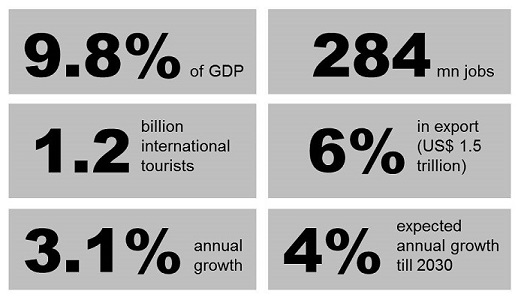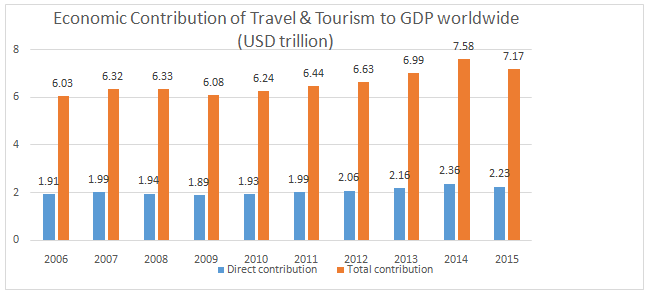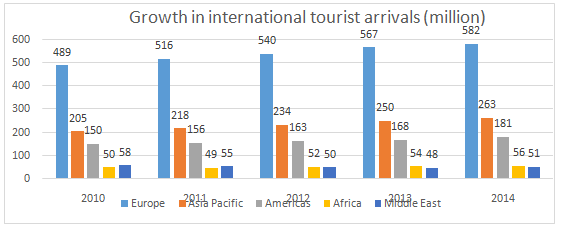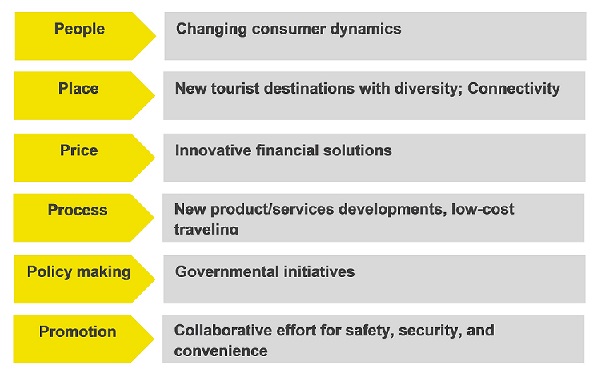1.1. Global tourism sector overview
Over past six decades, tourism has continuously expanded and diversified with ever-increasing number of destinations, to become one of the largest and fastest-growing economic sectors in the world. In a broader sense, Tourism is about travel, travellers and visitors, which creates opportunities for various businesses and influences wide range of industries. These industries that provide consumption goods and services together constitute the ‘Tourism Sector’. Hence, tourism is not only a growth engine but also an employment creator, impacting both the economic and socio-cultural development of a country. Key highlights of the impact of tourism sector, globally, is mentioned in the image below:

1.2. Economic contribution
The Travel & Tourism (T&T) industry is the largest contributor to employment and economy, which is 9.8% of the global GDP (US $7.2 trillion) in 2015 (exceeding forecast of 9% contribution), including direct, indirect and induced impacts. Despite the slow economic growth, the tourism sector has shown significant resilience globally. Despite global economic uncertainty, the sector grew by 3.1% in 2015.
This upward trend in T&T sector is likely to continue over next two decades, at an expected annual growth of 4% – faster than financial services, transport and manufacturing sectors.
Tourism added 7.2 million jobs to the global economy, about 1 in 11 jobs globally . One job in the core tourism industry creates about one and half indirect jobs in tourism-related economy. Furthermore, for accommodation industry, for each of the core job supports three indirectly dependent jobs .

Being a labour intensive sector, tourism offers huge employment opportunities to ensure delivery and quality of products and services. People are central to the effective operation and flourishing of the tourism industries, hence labour is treated as human capital.
1.3. Growth in number of international tourists
The number of international tourist arrivals has increased steadily almost every year; especially the new tourist destinations have started gaining more traction over the maturing traditional destinations. International tourist arrivals grew above-average by 4.4% reaching a record 1.2 billion in 2015 (50 million more tourists than previous year), a trend which continued for past six consecutive years.
In 2014, Europe, the most visited region had largest and most mature destinations, which accounted for 51% of all the international arrivals. However, Americas showed the highest growth of over 8% in the international arrivals (compared to +3% in Europe), followed by Asia and Pacific as well as Middle East (both by + 5%).

By 2030, the number of the international arrivals is forecasted to exceed 1.8 billion. And, while Europe and Americas are expected to witness modest growth rates of 2.5% and 2.2% respectively, Asia Pacific and Africa regions are expected to witness higher growth rates of 5.7% and 5% per annum during the same period.
1.4. Growth drivers
Tourism is greatly dependent on people, natural and built environment of a country, and vice versa it hugely impacts all those. Some of the key growth drivers behind the record growth in the travel and tourism sector are:

1.5. Global Tourism industries and products
In last few decades, the trend is moving towards niche segments of tourism, such as medical tourism, eco-tourism, adventure tourism, heritage tourism, etc.
Medical Tourism is a high-growth industry driven by rising health-care costs in developed countries and improving connectivity with the developing countries. More than forty countries in Asia, America, Africa and Eastern Europe are serving millions of medical tourists annually, for cosmetic surgery, cardiac surgery, dentistry and orthopaedic surgery.
Thailand, Singapore, Malaysia and India are the major destinations in the Asian medical tourism market, while Turkey is favoured medical tourism market in Eastern Europe. Thailand is more popular among Western European tourists for cosmetic surgery, due to lower costs, latest medical technology, and alternative medicine while offering multiple popular tourist destinations. Singapore and India specialize in complex procedures with India having a cost advantage and Singapore a technology advantage.